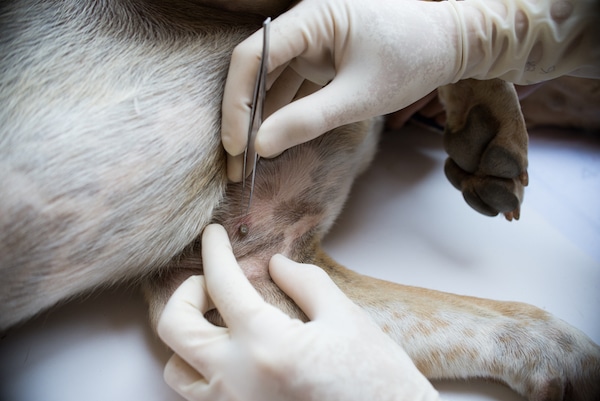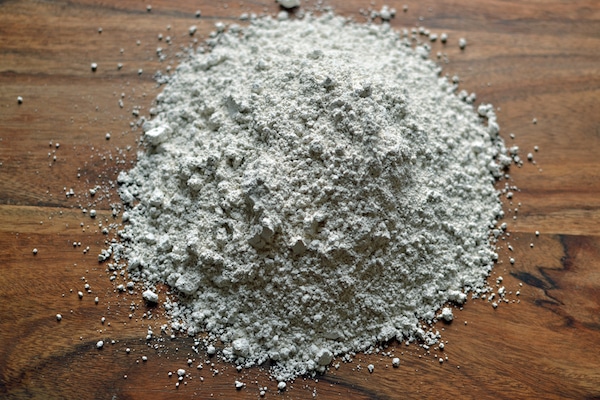While out and about during the colder months, I’ve encountered the occasional pet parent who balks at the use of conventional flea and tick treatments. Some don’t feel they’re necessary in chillier temperatures; others feel they’re unsafe overkill all year long. Upon further inquiry, I’ve heard about a range of intriguing alternative tactics that — quite honestly — sound just a smidge messy and inconvenient. Of course, my key question is always about effectiveness. That’s what led me to research a few of these natural preventive measures.
Before turning to the methods themselves, it’s probably worth noting that flea and tick infestations pose numerous potential problems. First, it’s just plain annoying to have creepy-crawly varmints flitting to and fro in your personal space. Second, both fleas and ticks can develop an attachment to dogs, other pets, even humans. Third, both pets and people may experience allergic reactions to flea bites. Fourth — and perhaps most worrisome — these little stinkers can carry and transmit actual disease.
The American Veterinary Medical Association notes that even the tiniest ticks can be responsible for spreading a number of harmful pathogens and ailments with a single bite — including Lyme disease, Rocky Mountain spotted fever, and hepatozoonosis. These illnesses can take a considerable toll on hounds and humans alike.

Vet removing tick from a dog by Shutterstock.
Moreover, if you’ve ever struggled through a flea infestation, you know these critters multiply like wildfire. Once fleas have found their way into your living quarters, showing them the door can be a huge and protracted hassle. As the saying goes, if you’ve seen one flea, there are probably hundreds more incubating in the near vicinity.
The University of California Division of Agriculture and Natural Resources notes that the average adult female flea can lay 20, 30, 40, even 50 eggs per day. So no matter how many adult fleas you manage to eradicate, maturing future fleas are still waiting in the wings. Just a couple on your pet can lead to intense itching — especially if your pup is one of many who struggles with FAD (flea allergy dermatitis), a systemic reaction to flea saliva. Fleas can also transmit tapeworms and even cause anemia, making their impact far worse than mere discomfort and fur loss.
The point is, when it comes to tiny visitors like fleas and ticks, even a miniscule margin of error can make for a pretty pesky problem. Of course, standard “pharmaceutical” control involves the use of chemical repellents. That means we’re either applying insecticide-type liquids to our pet’s skin or dispensing flavored chews that contain similar substances. These ingredients can sometimes lead to skin-level irritation … and for certain dogs, allergic reactions or worse. Also, failure to carefully follow label instructions could mean applying too much or too little to get the job done. And it’s true that over time, fleas and ticks may become resistant to certain compounds.
But do truly effective natural alternatives really exist? It’s a compelling question— because fleas and ticks can sometimes persist in unexpected spaces, across a wide range of climates and temperatures. And keep in mind that if you plan on boarding or professionally grooming your pet, you may need to furnish proof that you’ve applied a commercial preventive. That’s largely because such products are subject to standardized testing that helps establish predictive levels of effectiveness. Natural remedies don’t always carry a similar degree of broad, research-based data to reinforce efficacy.
Perhaps for this reason, several pet parents who go this route tell me that they tend to use several natural approaches simultaneously. But a word of warning: While no method can claim airtight-levels of 100 percent effectiveness, staying one step ahead of fleas and ticks requires unwavering persistence. So if you decide to forego commercial repellents altogether, it’s possible you’re taking a sizable chance. That said, for those curious about natural options, here are a few to explore:
1. Diatomaceous earth

Diatomaceous earth by Shutterstock.
This chalky, powder-like substance is actually the fossilized remains of single-celled algae. It’s deadly to many insects, including fleas; and while topical contact is technically harmless to pets and people, breathing it in may irritate nasal passages. Keep in mind that while this approach has demonstrated some effectiveness controlling flea infestations, it’s also somewhat messy.
If you’d like to give it a go, holistic veterinarian Dr. Richard H. Pitcairn suggests that you begin by thoroughly cleaning and vacuuming floors and furniture multiple times per week. He also recommends laundering all pet bedding in hot, soapy water at least once per week. The goal here is to pick up adult-stage pests, eggs, larvae, and pupae. In the midst of all this, two or three times per year, Dr. Pitcairn recommends sprinkling unrefined diatomaceous earth under furniture, along walls, on carpets, over pet bedding, into cracks and crevices throughout your home, even onto your pet’s back. If you’re a bit of a dusk freak, this may not be the method for you.
2. Lemon tonic
Famed English animal herbalist Juliette de Bairacli-Levy noted that fleas dislike citrus. Her text The Complete Herbal Book for the Dog recommends taking advantage of this fact by thinly slicing a whole lemon, including the rind. Add 2 cups of boiling water, let it steep overnight, and then spray the solution over your dog (avoiding the eye area).
This “lemon tonic” evidently contains natural flea-killing compounds, including d-limonene. Bathing your pet weekly with natural shampoos containing d-limonene and/or neem oil would be another option. Remember, however, that lemon may bleach darker fur in the sun over time.
3. Garlic

Garlic by Shutterstock.
A number of holistic vets — such as Dr. Pitcairn and one of his former associates, Dr. Lori Tapp — maintain that dogs under 50 pounds can be fed up to a ½ teaspoon of garlic per day, and dogs over 50 pounds can eat as much as 1 or 2 teaspoons per day. Garlic contains compounds that are secreted through the skin, and most fleas and ticks find these compounds fairly distasteful.
But it’s well worth remembering that garlic safety remains a hugely contentious topic when it comes to canines. Many mainstream vets strongly discourage its use in any amount, noting that it can lead to a certain type of anemia and other health issues. If you do choose to go this route, confer with a trusted animal health practitioner and proceed with caution.
4. Herbs and oils
These days, it’s not hard to find several brands of natural powders and sprays that claim to help repel tiny visitors. Most of these products contain some combination of eucalyptus, fennel, rosemary, yellow dock, rue, and/or wormwood. A few also contain natural pyrethrins, which don’t necessarily kill fleas but are said to discourage them from populating.
Holistic veterinarian Dr. Jeffrey Levy also mentions that the combination of citronella and cedarwood essential oil appears to help repel ticks. You can try mixing the two oils together, then combining 1 part oil to 10 parts alcohol and misting this onto your pet’s fur regularly. Bear in mind, however, that some pets will be attracted to the aroma and may constantly try licking it off. Also, alcohol can be extremely drying for dogs with certain existing skin issues, so close monitoring is key.
5. Cedar wood
A new pet collar called Derevos aims to take advantage of Eastern Aromatic and Siberian Red cedar wood properties. According to the Derevos website, both types of cedar are considered a natural defense against fungus and various insects such as mosquitos, fleas, flies, and ticks. This chemical-free, aromatic option lasts two to three months; can be used by both pets and humans; and is easily refreshed by applying cedar oil directly the collar.
It may be noteworthy to mention that critics of conventional flea and tick collars argue that protection is sometimes position-specific (i.e., limited to the head and neck region). That said, the makers of Derevos have launched a Kickstarter campaign, and plan to use financing to launch a range of design categories including collars, bracelets, necklaces, and more.
Have you ever experimented with natural flea and tick treatments? What was the result? Share your insights below.
The post Have These Natural Flea and Tick Preventatives Worked for Your Dog? appeared first on Dogster.
No comments:
Post a Comment